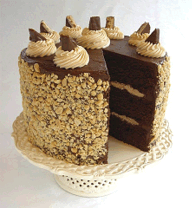
The first step in recipes mixed with the Creaming Method, are typically SHORTENED (BUTTER) CAKES and some COOKIES. You will recognize it when the recipe indicates: “Cream butter and sugar together until light and fluffy”; or “Beat butter and sugar together until light in color”; or any combination of those descriptions.
Creaming is one of the most important mixing methods used in the entire recipe. It incorporates the maximum amount of air bubbles created by dry crystalline sugar, typically granulated white table or super-fine, or brown sugar, beaten with plastic solid fat (stick butter or margarine, shortening or lard), so a recipe will rise in the oven and be light in texture when baked. The cake rises from these air bubbles expanding from the heat of the oven, steam generated from the liquid ingredients and from carbon dioxide generated from the chemical leaveners or baking powder and/or baking soda.
Most recipes call for beating the butter WITH the sugar as the initial mixing step. However, creaming should be done by first softening the solid fat, accomplished by using an electric stand mixer fitted with a paddle attachment, or hand-held mixer fitted with its beaters, or by hand with a large wooden spoon. If shortening AND butter are to be creamed with sugar, initially, do not beat the two fats together; first beat the shortening, then add the butter and beat the two together. Then, the sugar should be added slowly while beating to create air bubbles held in by the fat. The mixture is beaten until it is lightened in color and often described as fluffy from its tiny air bubbles.
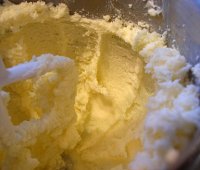 LIGHT AND FLUFFY – WHAT DOES THAT MEAN?
LIGHT AND FLUFFY – WHAT DOES THAT MEAN?
This is kind of a misnomer; the beaten solid fat and sugar mixture actually has many visual attributes. Here's what to look for:
1. Volume of the butter and sugar has increased;
2. Color of the butter has become lighter (described as pale ivory) from its incorporation of air bubbles;
3. Texture becomes aerated and is creamy while the butter still retains its plastic-like shape;
4. The mixture has numerous ridges in it from the beater blades and is sticky when scraped from the beater blades and bottom and sides of the bowl or when the blades are lifted:
5. The mixture coats the bottom and slightly up the sides of the bowl, an 1/8 to a 1/4-inch thick; and,
6. When touched, it will have the consistency of thick, somewhat gritty (from the sugar) facial cream (sorry–couldn't think of anything else).
7. The mixture should be somewhat cool.
Creaming butter and sugar until light and fluffy can sometimes be a misnomer, especially if you have little sugar and butter (fat), as in the case of COOKIE RECIPES, or less butter when baking reduced-fat HEALTHY BAKING RECIPES, which I call the “Healthy Oven Reduced-Fat Creaming Mixing Method.” In those cases you will never reach the light and fluffy stage, rather the final mixture will feel more like creamy sand.
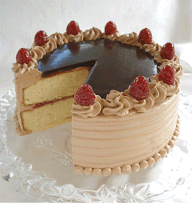 One of the most common mistakes is to either over or under-cream the fat and sugar together, cream with the mixer on too fast or to use fat that is too warm. When the mixture is over-creamed, creamed too fast or the fat is too warm, the fat starts to break down and release the previously creamed-in air bubbles. With butter, the milk solids separate, causing it to lose air and/or not be able to form air bubbles when the sugar crystals cut into it. This results in a whole host of problems, such as dense, flat and flavorless recipes (even cookies).
One of the most common mistakes is to either over or under-cream the fat and sugar together, cream with the mixer on too fast or to use fat that is too warm. When the mixture is over-creamed, creamed too fast or the fat is too warm, the fat starts to break down and release the previously creamed-in air bubbles. With butter, the milk solids separate, causing it to lose air and/or not be able to form air bubbles when the sugar crystals cut into it. This results in a whole host of problems, such as dense, flat and flavorless recipes (even cookies).
SARAH SAYS: I have watched bakers creaming butter and sugar until it is really fluffy. What happens is the butter and sugar starts to melt and become greasy around the edges of its fluffy mass, meaning it is too warm and/or you haven't scraped down the mixer blades and bowl adequately.
BUTTER TEMPERATURE
Most cookbooks suggest using “room temperature” butter. That typically means that the butter sits out of the refrigerator for about 20 to 45 minutes, and some think it means an indoor temperature of from 68 to 77 degrees F (20 to 25°C). Many times, the butter becomes too soft, greasy or melts. (Butter, in fact, melts at 68 degrees F). If done right, butter should be 65 degrees F and give slightly when pressed with a fingertip, cold to the touch but warm enough to spread. If not done in advance, there are lots of tips on how to microwave butter just right to soften rather than melt it, and many times this will cause the outside of the butter to become too warm. If this happens, the butter should no longer be used for creaming. It's because butter is of water in fat, with some dairy solids that help hold them together. Once butter is melted, it’s gone – it cannot be used for creaming. Warm butter can be rechilled and refrozen, but once the butterfat gets warm, the emulsion breaks, never to return.
Through my research and testing, I have found that room temperature butter is too warm when creaming with sugar while using a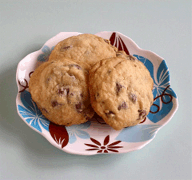 n electric stand mixer. In fact, if you start with room temperature ingredients and use an electric mixer, the finished batter will be too warm. The optimal ending temperature for butter cake batter should be around 68 – 72 degrees F.
n electric stand mixer. In fact, if you start with room temperature ingredients and use an electric mixer, the finished batter will be too warm. The optimal ending temperature for butter cake batter should be around 68 – 72 degrees F.
SARAH SAYS: Thus, I recommend using butter (and, other perishable) ingredients cold, right from the refrigerator, because today we use electric mixers. The friction caused by the electric beaters quickly warms the creamed butter and sugar for you, in about a minute or so. (Note: the exact mixing time is dependent on the amount of butter and sugar being creamed.) It helps keep the creamed butter from softening too much during the rest of the cake mixing process, releasing air bubbles and producing off results.
I believe that originally, room temperature ingredients were necessary to aid in the mixing process when butter cakes when mixed BY HAND with a wooden spoon; the butter was softer(at room temperature) and would cream more readily with the sugar. As I write in my Baking 9-1-1 Book (Simon and Schuster, 2003):
“SARAH SAYS: Today, we use electric stand mixers most of the time and they warm the ingredients. This may sound blasphemous, but I think the whole room temperature thing is old-fashioned. I usually use ingredients cold from the refrigerator except for temperature sensitive ingredients such as chocolate. In the case of creaming butter and sugar, cold butter will take longer to get to the right consistency before you can add the sugar, but it will get there.” – I counted 60 seconds!”
HOW TO CREAM WITH A STAND MIXER
It is important to start on low to medium-low speed until all ingredients have been incorporated, then switch to medium to medium-high speed, making sure to scrape the bowl down periodically to make sure all ingredients have been mixed thoroughly.
To do:
1. Add the butter stick(s) to the mixing bowl of a stand mixer, fitted with a paddle attachment. When the butter is still cold, but takes the imprint of a finger when gently pressed, it is ready to be creamed.
If the butter is solid from the cold or your stand mixer is not powerful enough, you can cut it into tablespoon sized pieces before using. Refrigerate the pieces briefly if too warm or soft. Never use a microwave: it will melt it, even though it will look solid.
SARAH SAYS: The temperature of the butter will be around 42 to 44 degrees F. I measured it by sticking the end of an Instant Read Thermometer in the middle of the stick butter, and holding it there for a few minutes.
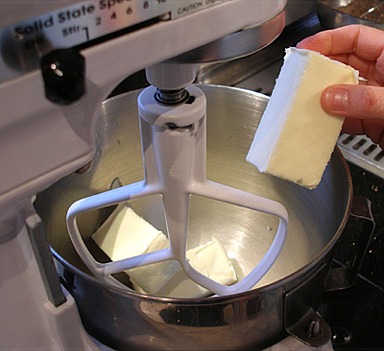
2. Beat the butter on low (or medium-low)until softened. It will take about 60 seconds or less, depending on the amount.
SARAH SAYS: When using a stand mixer, never go above medium speed, or the butter will heat up.
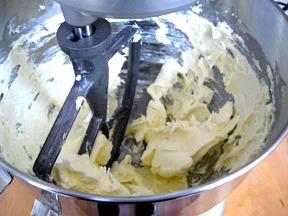
Stop and scrape the beaters and the sides and bottom of the bowl.
SARAH'S TIP: If you run the mixer at high speed for a few seconds, the butter will magically clear from the mixer blades. Then, scrape the bowl.
SARAH SAYS: Afterwards, the temperature of the butter mass will be around 60 degrees F. I measured it by gathering it together with a rubber spatula, then sticking the end of an Instant Read Thermometer in the butter mass, and holding it there for a few minutes.
3. Add the sugar in a steady stream at the side of the bowl with the mixer on low.
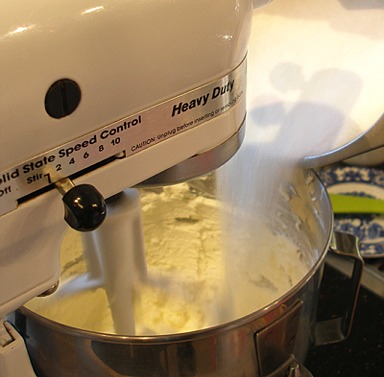
4. Increase the mixer speed to medium and beat for 1 or 2 minutes until lighter in yellow and somewhat aerated.
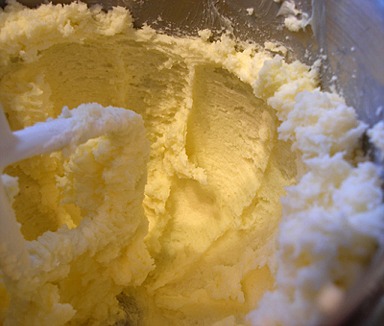
Stop the beater blades, and with a large rubber spatula, scrape the blades and the mixer bowl's sides and bottom.
SARAH SAYS: Afterwards, the temperature of the butter/sugar will be around 63 to 65 degrees F. I measured it by gathering it together with a rubber spatula, then sticking the end of an Instant Read Thermometer in the middle of the mass, and holding it there for a few minutes.
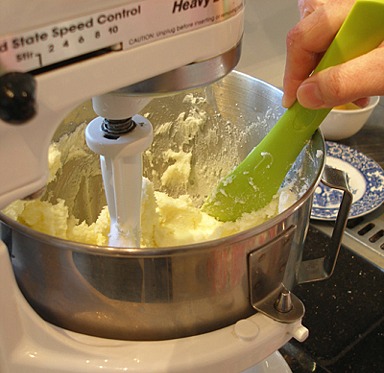
5. Next, if it is a shortened cake, the (cold) eggs are added gradually in stages, with the mixer on low. The yolks help emulsify and hold moisture within the formed air cells and create a water-in-fat emulsion.
NOTE: If the eggs are cold, the batter will curdle slightly. It's ok. The temperature of the mixed ingredients stayed around 63 degrees F.
6. Then, starting with the flour and dry ingredients, add it with the liquid (cold milk) alternately in stages. The mixture will curdle slightly from the cold milk, but will be corrected with the addition of flour.
7. After completing the last addition of flour, stop the mixer, and scrape the side and bottom of the bowl with a large rubber spatula. Then, let the mixer run for 30 seconds on LOW. The batter should look mixed. Do NOT overmix. Remove the mixing bowl from the mixer. With a large rubber spatula, give the batter ONE or TWO quick folds to incorporate any stray flour or milk left at the sides and bottom of the bowl. Then, STOP!
SARAH SAYS: Afterwards, the temperature of the batter was around 68 to 72 degrees F, which is optimal for a butter cake. I measured it by sticking the end of an Instant Read Thermometer in the middle of the batter mass, and holding it there for a few minutes.
HOW TO CREAM BY HAND WITH A SPOON
Some cream the butter and sugar by hand (I know my grandmother did) in a bowl with a large wooden spoon, but for beginners, I recommend using an electric mixer. She left the butter to sit at room temperature for an hour to soften, beat the butter first to soften and then added sugar. My grandmother then beat it to light, fluffy mass and only she could get it perfectly. For cold, hard butter, use the following system: cut the butter into 1/2-inch pieces and place it with the sugar in a mixing bowl set over barely simmering water. Beat with a wooden spoon for several seconds until the butter softens. Then set the bowl in a basin of cold water and beat for a minute or two until the mixture is light, fluffy, and a pale ivory color.
HOW CREAMING WORKS
When butter and sugar are creamed together, the rough sugar crystals cut into the fat, creating air bubbles that are held in by it. These small air bubbles serve as a nuclei for leavening gases, steam and heat. If the fat and crystalline sugar is adequately creamed, the entrapped air is more evenly dispersed amount the fat leading to a better and more even rising.
Creaming is forming a foam by incorporating air bubbles in a fat by stirring. Creaming fat is somewhat similar to beating eggs or egg whites, in that the enclosed air later aids in leavening. Air is enclosed in the fat more rapidly after some sugar is added, hence creaming is usually done by adding the sugar to the fat, either gradually during the creaming process, or all at one time. The sugar absorbs a portion of the fat on its surface and is suspended in the fat. In addition the sugar crystals aid in supporting the fat in the walls around the air bubbles in much the same manner as the fat globules in whipped cream. For a fat to cream or form a foam it must have some body, for if it is too warm so that it is partially or entirely melted it does not cream. On the other hand, a fat that is hard and brittle and not plastic does not cream well.
It's important to remember that leaveners simply enlarge the air bubbles that already exist in the batter; they do not create more. A cake or cookie will rise when chemical leaveners, such as baking soda and/or baking powder, are moistened and heated, steam is generated from the liquid ingredients and heat from the oven. Chemical leaveners will release carbon dioxide which gravitate to the air bubbles and expand them like tiny balloons. If not done properly, the result will be a cake that has risen more on one side, one that has not risen to its fullest potential or one that will first puff in the oven and then fall, causing it to be flat.
Different types of fat are better for holding air bubbles than others: shortening or lard, create and hold air bubbles the best but, stick butter is good, too. (Butter has the best flavor, however.) Margarine does not hold air as effectively, while vegetable oil doesn't at all.
Sugar crystal size affects creaming; the smaller the air nuclei formed during mixing, the more fine and close the texture. Thus, superfine sugar is often used in delicate cake recipes where a fine texture is desired. The sugar crystals are super small and create tinier air bubbles than when using regular crystalline sugar.
QUESTION: What if the recipe calls for creaming vegetable oil with butter. Does it work the same way?
SARAH SAYS: If there is little butter called for in the recipe, with additional vegetable oil, cream the butter and sugar together, first. It may not get light and fluffy, but will be rather sandy in texture. Then, add in the vegetable oil with the liquid ingredients; liquid fat cannot be creamed with solid fat as vegetable oil cannot create and hold air bubbles.
QUESTION: What if a recipe calls for beating shortening and butter with sugar. Do I simply add the two together?
SARAH SAYS: Do not add the shortening and butter together. First, beat the shortening until softened. Then, add in the butter and beat until softened. The addition of crystalline sugar follows. The reason is the two fats do not soften at the same rate. Room temperature shortening will have a tendency to soften faster than butter, and can rarely be overbeaten. By adding the butter last, you can avoid overbeating it.
QUESTION: I left my butter too long at room temperature and it is now really soft and greasy. Can I use it in the recipe?
SARAH SAYS: I do not advise doing so. Use a fresh stick of butter from the refrigerator; it can be beaten cold.
QUESTION: What if my creamed butter and sugar are not used right away in the recipe. Should I just leave it out at room temperature?
SARAH SAYS: Cover and place it in the refrigerator. Then, beat on medium-low for a minute or two to soften before using in the recipe. Do not let the butter get too warm.


